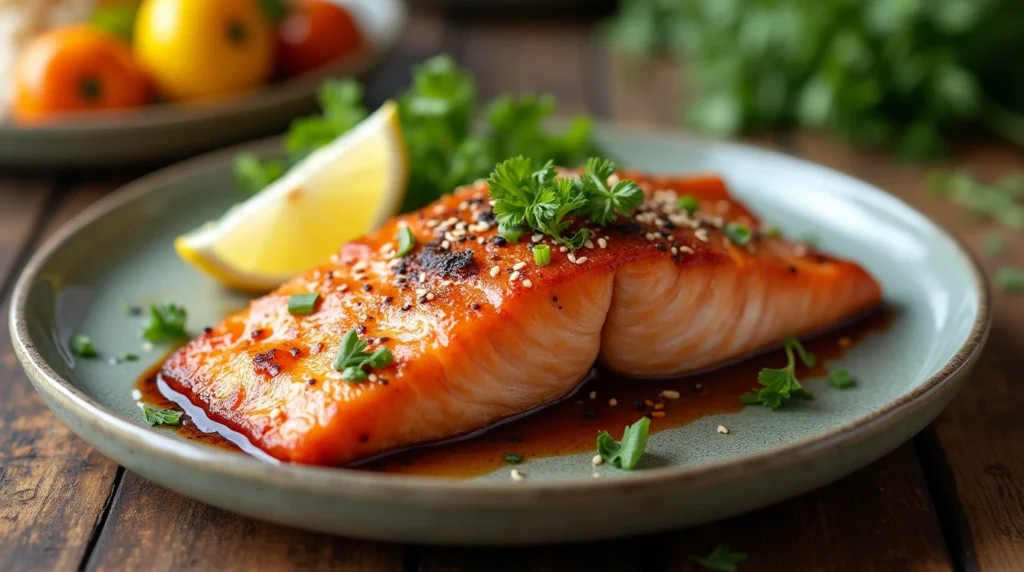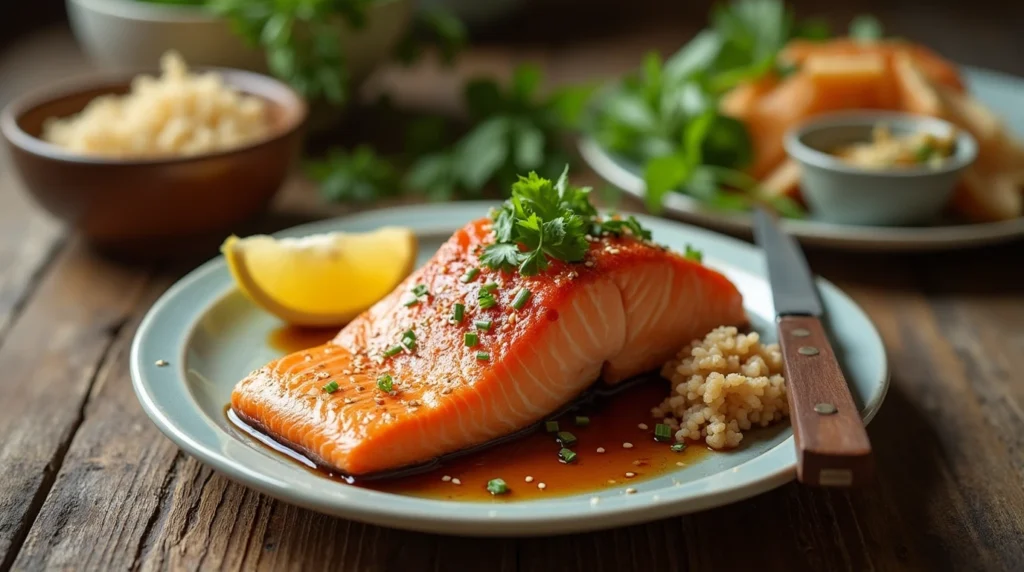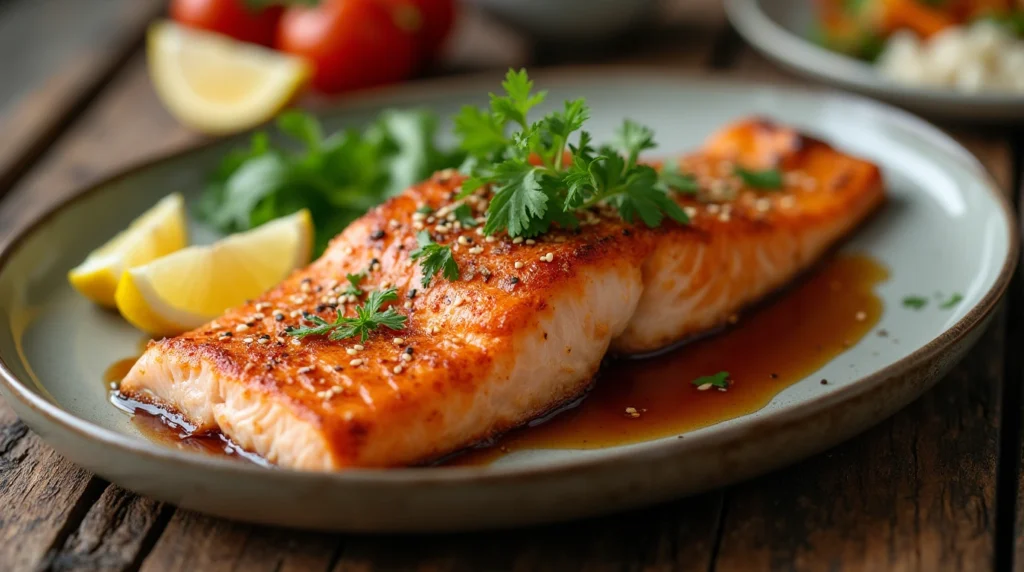Introduction
Salmon kama, also known as salmon collar, is an exquisite cut of fish that offers tender, flavorful meat. If you’ve ever tried it at a sushi restaurant or seafood grill, you know just how delicious this part of the fish can be. But did you know that you can easily recreate this mouthwatering dish in your own kitchen? In this article, we will show you how to make a tasty salmon kama recipe at home. Whether you’re a seasoned chef or a beginner cook, our step-by-step guide will help you master this delicious dish.
What is Salmon Kama?
Salmon kama refers to the cheeks and collar of the salmon, which are considered some of the most flavorful parts of the fish. The collar, located just behind the head of the fish, is packed with rich, tender meat and is prized for its unique texture and taste. It is often served in Japanese cuisine, either grilled or baked, and is typically seasoned with simple ingredients to enhance the natural flavors of the fish.
In many parts of the world, the salmon collar is considered a delicacy and is a favorite among food enthusiasts. It has a satisfying mix of both tender meat and crispy skin, offering a unique dining experience that you won’t want to miss. Now, let’s dive into how to make a tasty salmon kama recipe at home.

Ingredients for Your Salmon Kama Recipe
ToTo prepare the perfect salmon kama recipe at home, you need to gather a few simple ingredients that will enhance the natural flavors of the salmon collar. This dish is all about highlighting the rich, tender meat and crispy skin of the salmon, so the seasoning should complement, not overpower, the fish. Let’s go into more detail about each ingredient, so you know exactly what to use for the best result.
1. Salmon Collars (2-4 pieces)
The star of the dish, salmon kama, refers to the collar portion of the salmon, which is located just behind the head and around the gills. This cut is prized for its tender, flavorful meat, and it often has a perfect balance of fat and texture, making it ideal for grilling, baking, or pan-searing. Salmon collars are often overlooked, but they provide a unique and delicious experience that is definitely worth trying. You can purchase salmon kama at most seafood markets, and some grocery stores also carry this cut, particularly in areas with a strong seafood culture.
- Tip: If you can’t find salmon kama at your local store, you can substitute with other cuts of salmon like the belly or the cheek, though the flavor and texture will differ slightly.
2. Olive Oil or Vegetable Oil (1 tablespoon)
Olive oil or vegetable oil is used for brushing the salmon before cooking, as it helps prevent sticking and creates a beautiful crispy exterior. The oil also helps in browning the skin and seals in moisture, making the fish tender inside. Olive oil adds a subtle fruity flavor, while vegetable oil has a neutral taste.
- Tip: For a richer flavor, you can use sesame oil, which pairs wonderfully with the savory and slightly sweet marinade.
3. Soy Sauce (2 teaspoons)
Soy sauce is a key ingredient in many Asian-inspired recipes, and it works wonders for salmon kama. It provides a salty, umami-rich flavor that enhances the fish’s natural taste. The soy sauce also acts as part of the marinade, allowing the flavors to soak into the fish for a deeper taste. You can use either light or dark soy sauce, depending on the flavor intensity you prefer.
- Tip: If you’re looking for a gluten-free version, opt for tamari sauce as a substitute for soy sauce.
4. Lemon Juice (1 tablespoon)
Lemon juice adds a fresh, zesty contrast to the rich and savory flavors of the salmon. The acidity from the lemon helps to balance out the natural oils of the fish, creating a harmonious flavor profile. It also brightens up the dish and helps cut through the richness of the salmon collar.
- Tip: For an extra burst of citrus flavor, you can add lemon zest to the marinade or as a garnish before serving.
5. Grated Ginger (1 teaspoon)
Fresh ginger offers a mild, spicy kick and a fragrant aroma that enhances the overall flavor of the dish. It pairs exceptionally well with salmon, bringing a touch of warmth and complexity. Grated ginger infuses the marinade, giving the salmon collar a subtle yet distinctive flavor that complements its richness.
- Tip: If you don’t have fresh ginger on hand, ground ginger is a fine substitute. Use about half the amount as ground ginger is more concentrated.
6. Garlic Powder or Fresh Minced Garlic (1 teaspoon)
Garlic adds a savory depth to the marinade and complements the fish’s flavor perfectly. Whether you use garlic powder or fresh minced garlic depends on your preference. Fresh garlic offers a more robust flavor, while garlic powder provides a milder and more evenly distributed taste. Both versions are excellent for this recipe.
- Tip: For an extra layer of flavor, try roasting the garlic before adding it to the marinade. This brings out a sweeter, more caramelized flavor.

7. Honey (1 tablespoon)
Honey is used to introduce a touch of sweetness to the marinade, which balances the saltiness of the soy sauce and the acidity of the lemon. The natural sweetness of honey also helps to caramelize the fish, creating a slightly crispy, glossy finish when cooked. It’s a great way to add a subtle complexity to the dish.
- Tip: If you prefer a different sweetener, you can substitute honey with maple syrup or agave nectar. However, honey offers a more traditional and pleasant sweetness for salmon kama.
8. Salt and Pepper (to taste)
Salt and pepper are essential for seasoning the salmon kama and enhancing the natural flavors. Salt brings out the umami in the fish, while pepper adds a mild heat and earthy undertones. Use freshly ground black pepper for the best flavor.
- Tip: For extra flavor, try using sea salt or kosher salt, which have a coarser texture and less intense saltiness than regular table salt.
9. Fresh Herbs (Optional)
Fresh herbs can add a burst of freshness and color to the finished dish. While not required for the marinade, garnishing your salmon kama with fresh herbs can enhance the presentation and bring additional layers of flavor. Common herb options include parsley, cilantro, or green onions.
Tip: Garnish the salmon kama with a sprinkle of sesame seeds, chopped green onions, or cilantro right before serving for added texture and color.
How to Prepare Salmon Kama at Home
Step 1: Prep the Salmon Kama
Before you start cooking, it’s important to prepare the salmon collar properly. If you’re using frozen salmon kama, ensure it’s completely thawed before cooking. Pat the pieces dry with a paper towel to remove excess moisture. This helps the fish cook evenly and crisps up the skin.
Step 2: Marinate the Salmon Kama
In a small bowl, combine the soy sauce, lemon juice, grated ginger, garlic, and honey. Whisk everything together to create a flavorful marinade.
Place the salmon collars in a shallow dish or a resealable plastic bag and pour the marinade over the fish. Make sure all sides are coated evenly. Allow the salmon to marinate in the refrigerator for about 20-30 minutes. This allows the flavors to meld into the fish.
Tip: If you have time, marinate the salmon for up to two hours for an even deeper flavor.
Step 3: Preheat Your Cooking Surface
You have a couple of options for cooking your salmon kama: grilling, baking, or pan-searing. Here’s a quick breakdown of each method:
- Grilling: Preheat your grill to medium-high heat (about 400°F). Lightly oil the grill grates to prevent sticking.
- Baking: Preheat your oven to 375°F (190°C).
- Pan-searing: Heat a large skillet or frying pan over medium heat with a bit of oil.
Cooking Methods for Your Salmon Kama
Grilling Salmon Kama
To grill your salmon kama, place the fish on the preheated grill, skin-side down. Grill the salmon for about 4-5 minutes on each side. The fish should be opaque and easily flake with a fork when done.
Grilling imparts a smoky flavor that complements the rich taste of the collar, while the skin crisps up perfectly. This method adds a delightful char and texture to the dish.
Baking Salmon Kama
If you prefer a more hands-off approach, baking is an excellent option. Place the marinated salmon collars on a baking sheet lined with parchment paper. Bake for 15-20 minutes, depending on the thickness of the fish, until the flesh is opaque and flakes easily. This method helps preserve the moistness of the salmon while still allowing the skin to become crispy.
Pan-searing Salmon Kama
For a quick and crispy option, pan-searing is a great choice. Heat your pan over medium heat and add a little oil. Once hot, add the salmon collars, skin-side down, and cook for 3-4 minutes per side. This method creates a crisp exterior while keeping the inside tender and juicy.
Tips for the Best Salmon Kama Recipe
- Use fresh salmon: Fresh salmon kama will provide the best flavor and texture. If you can’t find fresh, frozen salmon kama is an excellent alternative.
- Don’t overcook the fish: Salmon kama is best when it’s slightly crispy on the outside and tender on the inside. Be sure to check the fish often to avoid overcooking.
- Experiment with seasonings: While the recipe calls for soy sauce, lemon, and honey, feel free to play around with additional seasonings like sesame oil, chili flakes, or a touch of miso paste for more depth of flavor.
- Serve with sides: Salmon kama pairs beautifully with steamed rice, sautéed vegetables, or a light salad. The combination of savory, sweet, and fresh flavors will elevate your meal.

Why You Should Try Salmon Kama
Salmon kama offers a unique culinary experience. It’s a cut of fish that many overlook but provides a truly special texture and flavor. The skin crisps up beautifully, and the meat remains rich and succulent, making it a memorable addition to your recipe repertoire.
Whether you’re a seasoned cook or new to preparing fish at home, salmon kama is a versatile and easy-to-make dish. You can enjoy it grilled, baked, or pan-seared, and it’s a fantastic option for weeknight dinners or special occasions.
Conclusion
Now you know how to make a tasty salmon kama recipe at home. With just a few simple ingredients and easy cooking methods, you can recreate this delicious and flavorful dish in your own kitchen. Whether you grill it, bake it, or pan-sear it, salmon kama is a great way to enjoy a healthy and satisfying seafood meal. Give it a try today and elevate your cooking with this savory fish collar recipe!
Frequently Asked Questions (FAQs)
What is salmon kama?
Salmon kama is the collar or cheek portion of the salmon, which is known for its tender, flavorful meat. It’s a prized cut in many cuisines, particularly Japanese.
What is the best method to cook salmon?
The best method to cook salmon depends on your preference. Grilling, baking, and pan-searing all produce excellent results, but the key is not to overcook the fish. A crispy exterior with tender, juicy meat inside is the goal.
Are salmon collars good?
Yes! Salmon collars are delicious and often more flavorful than other parts of the fish. The meat is rich, tender, and pairs wonderfully with simple seasonings.
How to bake salmon collar?
To bake salmon collar, preheat your oven to 375°F (190°C), season the fish, and bake for 15-20 minutes until the fish is opaque and easily flakes.
How to eat salmon collar?
Eat salmon collar by scraping the meat from the bones. It’s delicious with a little soy sauce or lemon for added flavor.
How long to keep salmon in the oven?
Bake salmon in the oven for about 15-20 minutes, depending on thickness. It’s done when the flesh is opaque and easily flakes with a fork.
For more recipes please click on below links:
Easy Sub in a Tub Recipe: A Perfect Sandwich-Inspired Bowl
Best Flank Steak Alternatives for Juicy and Tender Results
Easy Sloppy Joe Recipe with 3 Ingredients: Quick and Delicious

